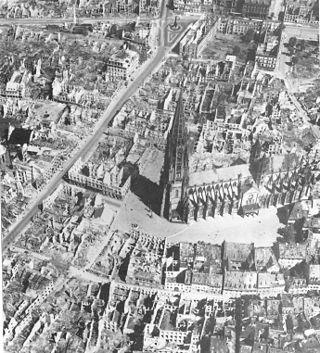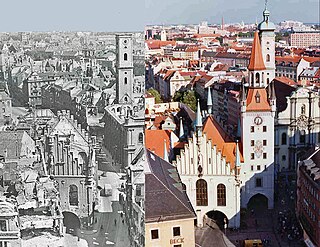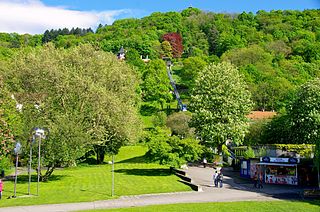
Ganter is a private brewery based in Freiburg, Germany. It was founded in 1865 by Louis Ganter, and as of 2016 is run by Katharina Ganter-Fraschetti and Detlef Frankenberger.

Engelbert Zaschka was a German chief engineer, chief designer and inventor. Zaschka is one of the first German helicopter pioneers and he is a pioneer of flying with muscle power and the folding car. Zaschka devoted himself primarily to aviation and automotive topics, but his work was not limited to them.

Freiburg Hauptbahnhof is the central railway station of the German city of Freiburg im Breisgau. The Rhine Valley Railway (Mannheim–Basel), Höllentalbahn and the Breisach Railway (Breisach–Freiburg) meet here.

Operation Tigerfish was the military code name in World War II for the air raid on Freiburg in the evening of 27 November 1944 by the Royal Air Force with about 2,800 dead.

The Siegesdenkmal in Freiburg im Breisgau is a monument to the German victory in the Franco-Prussian War in 1871. It was erected at the northern edge of the historic center of Freiburg im Breisgau next to the former Karlskaserne (barracks). After World War II it was moved 100m to the west. Today it is located on Europaplatz.

Stühlinger is a district to the west of the historic city center of Freiburg im Breisgau. In December 2013, 18,300 residents lived in the neighborhood. There are three boroughs: Stühlinger-Beurbarung, Stühlinger-Eschholz and Alt-Stühlinger. Although historically correct, the railroad Freiburg-Colmar is the north end of the Stühlinger and therefore Stühlinger-Beurbarung is not part of the district anymore. The district borders the area of the central train station of the Deutsche Bahn AG to the east, the river Dreisam to the south, tracks of the railroad freight transportation to the west and the district Brühl to the north.

The History of Freiburg im Breisgau can be traced back 900 years. Around 100 years after Freiburg was founded in 1120 by the Zähringer, until their family died out. The unloved Counts of Freiburg followed as the town lords, who then sold it onto the Habsburgers. At the start of the 19th century, the (catholic) Austrian ownership of the town ended, when Napoleon, after having invaded the town, decreed the town and Breisgau to be a part of the Grand Duchy of Baden in 1806. Until 1918, Freiburg belonged to the Grand Duchy, until 1933 to the Weimar Republic and Gau Baden in Nazi Germany. After the Second World War, the town was the state capital of (South) Baden from 1949 until 1952. Today, Freiburg is the fourth-largest city in Baden-Württemberg.
Fridolin Dietsche was a German sculptor from Baden.
Jürgen Förster is a German historian who specialises in the history of Nazi Germany and World War II. He is a professor of history at the University of Freiburg, the position he has held since 2005. Förster is a contributor to the seminal work Germany and the Second World War from the Military History Research Office (MGFA).

Wolfram Wette is a German military historian and peace researcher. He is an author or editor of over 40 books on the history of Nazi Germany, including the seminal Germany and the Second World War series from the German Military History Research Office (MGFA).
Gerd R. Ueberschär is a German military historian who specialises in the history of Nazi Germany and World War II. He is one of the leading contributors to the series Germany and the Second World War and, together with Rolf-Dieter Müller, is the author of Hitler's War in the East 1941−1945: A Critical Assessment. Both works have been published in English translations.
Horst Boog was a German historian who specialised in the history of Nazi Germany and World War II. He was the research director at the Military History Research Office (MGFA). Boog was a contributor to several volumes of the seminal work Germany and the Second World War from the MGFA. He was an expert on the Luftwaffe and the German side of the aerial war in Europe during World War II.

The aerial bombings of Hanover are a series of eighty-eight air raids by Royal Air Force (RAF) Bomber Command and the United States Army Air Forces (USAAF) on the German city of Hanover during World War II. Collectively these air raids killed 6,782 persons, predominantly civilian residents. Around 1,000 aerial mines, 34,000 high explosive bombs, 900,000 incendiary bombs and 50,000 fire bombs were dropped. The most destructive and deadly air raid on Hanover was conducted by the RAF on the night beginning 8 October 1943, killing 1,245 persons, and is an example of carpet bombing of suburban and residential civilian targets laid out in the Area Bombing Directive of 14 February 1942.
Ernst Klink was a German military historian who specialised in Nazi Germany and World War II. He was a long-term employee at the Military History Research Office (MGFA). As a contributor to the seminal work Germany and the Second World War from MGFA, Klink was the first to identify the independent planning by the German Army High Command for Operation Barbarossa.

The bombing of Munich took place mainly in the later stages of World War II. Munich was, and is, a significant German city, as much culturally as industrially. Augsburg, thirty-seven miles to the west, was a main centre of diesel engine production, and was also heavily bombed during the war. Although some considerable distance from the United Kingdom, Munich is not a difficult city to find from the air, mainly due to its size, and possibly its proximity to the Austrian Alps to the south-east as a visual reference point. Munich was protected (initially) by its distance from the United Kingdom. After a small air raid in November 1940 the city got little attention from bombers until 1944.

The Stadtgarten of Freiburg is a 2.6 ha park within the Neuburg district. It has an old tree grove and a large rose garden, and lies between the Leopoldring, Jackob Burckhardt, Ludwig and Mozart streets near Freiburg's city centre. It is connected to Karlsplatz via the Karlssteg footbridge, which is made from pre-stressed concrete. Since 2008 the Schlossberg Tram, an inclined elevator, leads up to Schlossberg. It replaced the Schlossberg Cable Car built in 1968.
Mooswald is a district in the western part of Freiburg im Breisgau, Germany, which consists of the two districts Mooswald West (521) and Mooswald East (522). Its population is 9,223 (2020). In the North East, Mooswald borders the district of Brühl, with its airfield, the university campus of the technical faculty and the exhibition centre. Mooswald further borders the district of Landwasser in the North West, the district of Stühlinger in the East and the district of Betzenhausen with the Seepark in the South West. Mooswald is separated from Brühl by the Breisgau S-Bahn, from Landwasser by the Westrandstraße (Paduaallee/Mooswaldallee) and from Stühlinger by the railway tracks of the freight railway.

The Platz der Alten Synagoge is a square in Freiburg, Germany. With a size of 130 square metres, it is the second largest square in the city after Minster Square. The square is named after the old synagogue, which was destroyed during the Kristallnacht in 1938. The synagogue had been built in 1869/1870 to the southwest of today's location of the square.
Heinz Magenheimer is an Austrian military historian known for advancing the now discredited theory of a preemptive strike by the Wehrmacht against the Soviet Union.

The Bismarck tower in Freiburg im Breisgau belongs to a series of towers that were built in honor of Otto von Bismarck, the first German chancellor. It is located on the Schlossberg. It is 12.6 m (41 ft) tall and has a square base. The top of the tower can only be reached by climbing a ladder. Because of this it can not be used as an observation deck.













